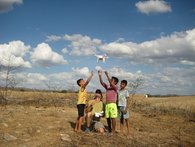Funding by: DAAD I CAPES
Funding ID:
Funding period: 01/2020 – 12/2023
Project partners: Federal University of Ceará (UFC), Brazil I Federal Institute of Ceará (IFCE), Brazil I University of Potsdam, Germany
The German-Brazilian cooperation between GFZ Potsdam, University of Potsdam, the Federal University of Ceará (UFC) in Fortaleza and the Federal Institute of Ceará (IFCE) in Maracanaú is jointly supported by DAAD and CAPES. The cooperation aims at monitoring water resources and improving the understanding of its complex dynamics based on in situ measurements, remote sensing technologies and modelling approaches in the North East of Brazil, a region referred to as the drought polygon.
The semi-arid region is characterized by pronounced wet and dry seasons. In the dry season, water supply is ensured by a large number of reservoirs of various sizes. However, the region regularly experiences long drought periods when low rainfall rates during the wet season result in insufficient refill of reservoirs demonstrating the need for an effective and integrated water resources management. In recent years, an increasing growth of macrophytes has been observed indicating an increase in eutrophication of the reservoirs that in turn is related to changes in land use. Particularly direct access of cattle to the reservoirs and the degradation of the natural Caatinga vegetation are supposed to be major causes of increased nutrient inflow. Given the large number of reservoirs, the complex dynamics of water storage and quality and the size and remoteness of the area, satellite remote sensing is believed to be an ideal source to assist monitoring of water resources as a basis for a sustainable water resources management.
Previous work of the project partners in the semi-arid NE of Brazil focused on investigating water availability, erosion and sediment transport processes, reservoir siltation, eutrophication, and sediment reuse for soil fertilization. Within the framework of this long-term collaboration, the SERES project aims at
- quantifying the impact of eutrophication on water availability of surface reservoirs,
- assessing how the sediment reuse technique can contribute to water quality recovery, and
- mapping nutrient availability in reservoir sediments and nutrient deficit in soils to support the sediment reuse practice.
In the SERES project, remote sensing technologies will be supported by in-situ measurements as well as numerical modelling.
Publications:
Zhang, S., Foerster, S., Medeiros, P., de Araújo, J. C., Duan, Z., Bronstert, A., Waske, B. (2021): Mapping regional surface water volume variation in reservoirs in northeastern Brazil during 2009–2017 using high-resolution satellite images. - Science of the Total Environment, 789, 147711. DOI
Braga, B. B., de Carvalho, T. R. A., Brosinsky, A., Förster, S., Medeiros, P. H. A. (2019 - )From waste to resource: Cost-benefit analysis of reservoir sediment reuse for soil fertilization in a semiarid catchment DOI
Pereira, B., Medeiros, P., Francke, T., Ramalho, G., Förster, S., De Araújo, J. C. (2019) - Assessment of the geometry and volumes of small surface water reservoirs by remote sensing in a semi-arid region with high reservoir density DOI
Pereira, F. J. S., Costa, C. A. G., Förster, S., Brosinsky, A., de Araújo, J. C. (2019) - Estimation of suspended sediment concentration in an intermittent river using multi-temporal high-resolution satellite imagery DOI
Zhang, S., Förster, S., Medeiros, P., de Araújo, J. C., Waske, B. (2018) - Effective water surface mapping in macrophyte-covered reservoirs in NE Brazil based on TerraSAR-X time series DOI
Coelho, C., Heim, B., Förster, S., Brosinsky, A., de Araújo, J. (2017) - In Situ and Satellite Observation of CDOM and Chlorophyll-a Dynamics in Small Water Surface Reservoirs in the Brazilian Semiarid Region DOI
Zhang, S., Förster, S., Medeiros, P., de Araújo, J. C., Motagh, M., Waske, B. (2016) - Bathymetric survey of water reservoirs in north-eastern Brazil based on TanDEM-X satellite data DOI







